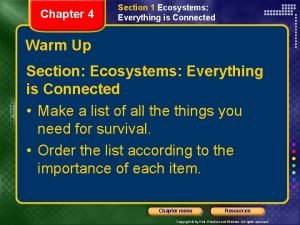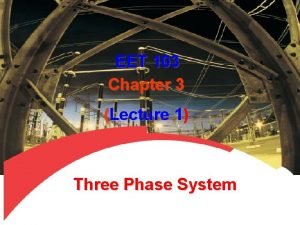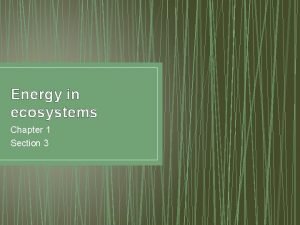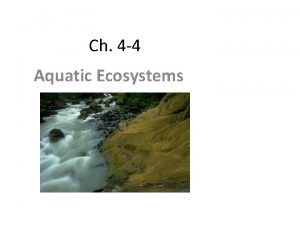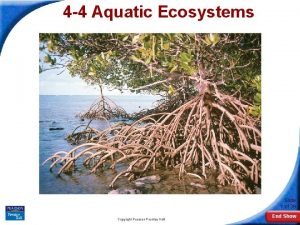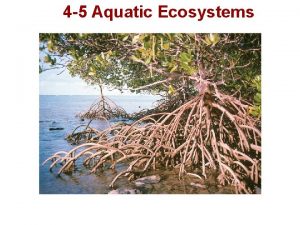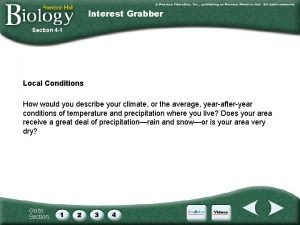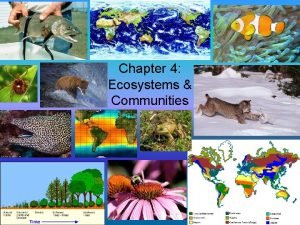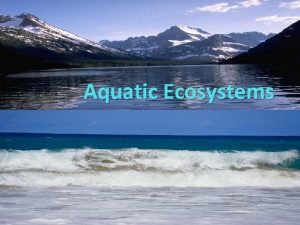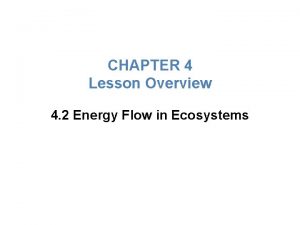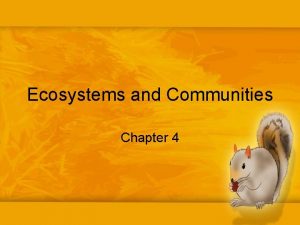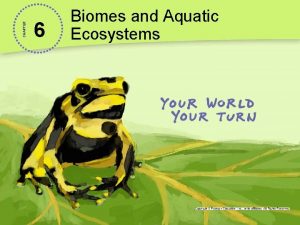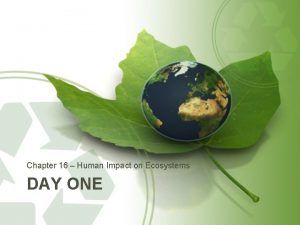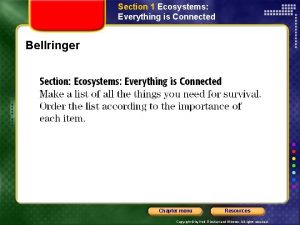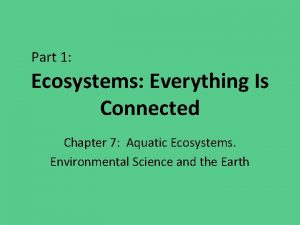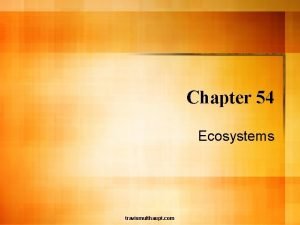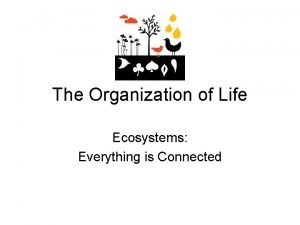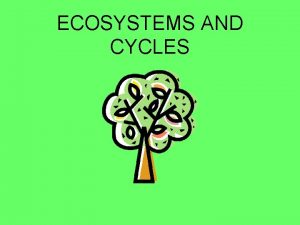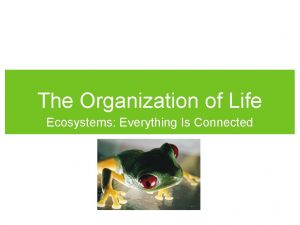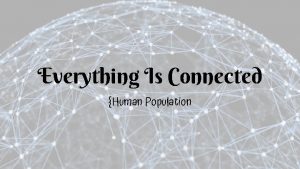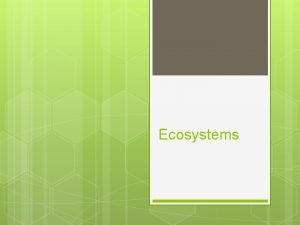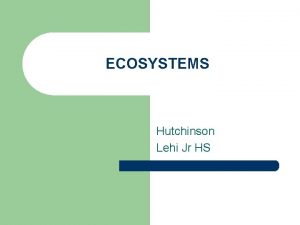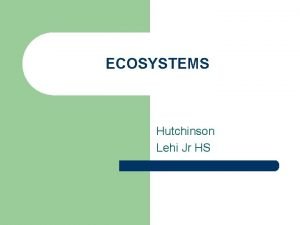Chapter 4 Section 1 Ecosystems Everything is Connected




















- Slides: 20

Chapter 4 Section 1 Ecosystems: Everything is Connected Objectives • Distinguish between the biotic and abiotic factors in an ecosystem. • Describe how a population differs from a species. • Explain how habitats are important for organisms. Chapter menu Resources Copyright © by Holt, Rinehart and Winston. All rights reserved.

Vocabulary for Unit 2 – on Page 10 (22 Words) Ecosystem Biotic Factor Abiotic Factor Habitat Adaptation Photosynthesis Cellular Respiration Producer/Autotroph Consumer/Heterotroph Pioneer Species Decomposer Food Web Food Chain Niche Eutrophication Primary Succession Secondary Succession Nitrogen Fixation 10% Rule Legume Nitrogen Fixing Bacteria Lichen Chapter menu Resources Copyright © by Holt, Rinehart and Winston. All rights reserved.

Chapter 4 Section 1 Ecosystems: Everything is Connected Defining an Ecosystem • Ecosystems are communities of organisms and their abiotic environment. • Examples are an oak forest or a coral reef. • Ecosystems do not have clear boundaries. • Things move from one ecosystem to another. Pollen can blow from a forest into a field, soil can wash from a mountain into a lake, and birds migrate from state to state. Chapter menu Resources Copyright © by Holt, Rinehart and Winston. All rights reserved.

Chapter 4 Section 1 Ecosystems: Everything is Connected The Components of an Ecosystem • In order to survive, ecosystems need five basic components: energy, mineral nutrients, water, oxygen, and living organisms. • Plants and rocks are components of the land ecosystems, while most of the energy of an ecosystem comes from the sun. • If one part of the ecosystem is destroyed or changes, the entire system will be affected. Chapter menu Resources Copyright © by Holt, Rinehart and Winston. All rights reserved.

Chapter 4 Section 1 Ecosystems: Everything is Connected Biotic and Abiotic Factors • Biotic factors are environmental factors that are associated with or results from the activities of living organisms which includes plants, animals, dead organisms, and the waste products of organisms. • Abiotic factors are environmental factors that are not associated with the activities of living organisms which includes air, water, rocks, and temperature. • Scientists can organize these living and nonliving things into various levels. Chapter menu Resources Copyright © by Holt, Rinehart and Winston. All rights reserved.

Biotic and Abiotic Video 1. The ______ contains living and nonliving thins. 2. Living things in an ecosystem are called _____ factors. 3. Living things include ______, ________, bacteria, fungi, and more. 4. The non-living things in an ecosystem are called _____ factors. 5. Some non-living things are ____, __________, water, atmospheric gases, and soil. 6. Plants use sunlight, water and CO 2 to make ______. 7. When the temperature gets too hot, turtles seek protection in the cool _____________. 8. All biotic factors need _________ to survive 9. When the temperature drops and the snow falls, some foxes grow a white fur _______. 10. The color matches its surroundings, a _________ known as camouflage. 11. Bacteria are __________. Chapter menu Resources 12. Nutrients reenter the soil making the ground _______. Copyright © by Holt, Rinehart and Winston. All rights reserved.

Biotic & Abiotic Factors https: //www. youtube. com/watch? v=E 1 pp_7 -y. TN 4 Chapter menu Resources Copyright © by Holt, Rinehart and Winston. All rights reserved.

Biotic and Abiotic Video 1. The ecosystem contains living and nonliving things. 2. Living things in an ecosystem are called biotic factors. 3. Living things include plants, animals, bacteria, fungi, and more. 4. The non-living things in an ecosystem are called abiotic factors. 5. Some non-living things are sun, temperature, water, atmospheric gases, and soil. 6. Plants use sunlight, water and CO 2 to make food. 7. When the temperature gets too hot, turtles seek protection in the cool underground. 8. All biotic factors need water to survive 9. When the temperature drops and the snow falls, some foxes grow a white fur coat. 10. The color matches its surroundings, an adaptation known as camouflage. 11. Bacteria are decomposers. Chapter menu Resources 12. Nutrients reenter the soil making the ground fertile. Copyright © by Holt, Rinehart and Winston. All rights reserved.

Chapter 4 Section 1 Ecosystems: Everything is Connected Levels of Ecological Organization Chapter menu Resources Copyright © by Holt, Rinehart and Winston. All rights reserved.

Chapter 4 Section 1 Ecosystems: Everything is Connected Organisms • Organisms are living things that can carry out life processes independently. • You are an organism, as is and ant, and ivy plant, and each of the many bacteria living in your intestines. • Every organism is a member of a species. • Species are groups of organisms that are closely related can mate to produce fertile offspring. Chapter menu Resources Copyright © by Holt, Rinehart and Winston. All rights reserved.

Chapter 4 Section 1 Ecosystems: Everything is Connected Populations • Members of a species may not all live in the same place. Field mice in Maine will not interact with field mice in Texas. However, each organism lives as part of a population. • Populations are groups of organisms of the same species that live in a specific geographical area and interbreed. • For example, all the field mice in a corn field make up a population of field mice. Chapter menu Resources Copyright © by Holt, Rinehart and Winston. All rights reserved.

Chapter 4 Section 1 Ecosystems: Everything is Connected Populations • An important characteristic of a population is that its members usually breed with one another rather than with members of other populations • For example, bison will usually mate with another member of the same herd, just as wildflowers will usually be pollinated by other flowers in the same field. Chapter menu Resources Copyright © by Holt, Rinehart and Winston. All rights reserved.

Populations, Communities, and Ecosystems Video 1. The population of ________ on earth is increasing everyday. 2. Scientists have measured the growth to be _______ new people every second. 3. Another example of a population is all of the ______ in the forest. 4. A population is a group of the ______ organisms living in an area. 5. Sometimes different __________ live in the same area. 6. There can be a population of ______ and a population of pine _______. 7. In a forest, a population of owls ______ with a population of mice. 8. An _________ is a term that scientists give to all of the living and non-living things in an area. 9. Examples of ecosystems: ______ and ________. 10. Populations are all members of ____ species. 11. Communities are _______ populations. 12. __________ include communities and the nonliving parts. Chapter menu Resources Copyright © by Holt, Rinehart and Winston. All rights reserved.

Populations Communities Video https: //www. youtube. com/watch? v=c. Ifp. KL 0 brw. Q Chapter menu Resources Copyright © by Holt, Rinehart and Winston. All rights reserved.

Populations, Communities, and Ecosystems Video 1. The population of people on earth is increasing everyday. 2. Scientists have measured the growth to be three new people every second. 3. Another example of a population is all of the owls in the forest. 4. A population is a group of the same organisms living in an area. 5. Sometimes different populations live in the same area. 6. There can be a population of mice and a population of pine trees. 7. In a forest, a population of owls interact with a population of mice. 8. An ecosystem is a term that scientists give to all of the living and non-living things in an area. 9. Examples of ecosystems: Forest and desert 10. Populations are all members of one species. 11. Communities are many populations. 12. Ecosystems include communities and the nonliving parts. Chapter menu Resources Copyright © by Holt, Rinehart and Winston. All rights reserved.

Chapter 4 Section 1 Ecosystems: Everything is Connected Communities • Communities are groups of various species that live in the same habitat and interact with each other. • Every population is part of a community. • The most obvious difference between communities is the types of species they have. • Land communities are often dominated by a few species of plants. These plants then determine what other organisms can live in that community. Chapter menu Resources Copyright © by Holt, Rinehart and Winston. All rights reserved.

Chapter 4 Section 1 Ecosystems: Everything is Connected Habitat • Habitats are places where an organism usually lives. • Every habitat has specific characteristics that the organisms that live there need to survive. If any of these factors change, the habitat changes. • Organisms tend to be very well suited to their natural habitats. If fact, animals and plants usually cannot survive for long periods of time away from their natural habitat. Chapter menu Resources Copyright © by Holt, Rinehart and Winston. All rights reserved.

Habitat Video 1. Does a polar belong in a desert? YES or NO 2. Animals need these too; _________, __________, shelter, and space to live. 3. Plants and animals all fall somewhere along the food chain, which is a model we use describe the flow of ________ between living things. 4. Food chains are actually all tangled around with each other; with many different ones __________, kind of like a web. 5. The plants, trees, grass, and other plants that change energy from the _______ into __________. 6. Today an owl makes a __________ his lunch, but tomorrow it maybe a rabbit. 7. Finally the decomposers, insects, fungi, and _____________ are breaking down whatever is left over. 8. As the break down matter, they provide more nutrients for the ___________. 9. Zoom way in. Can you see those tiny plants? They are call phytoplankton, and just like _________ on land they convert energy from the ________. 10. Real small creatures called zooplankton eat the phytoplankton, and all kinds of small ___ dine on the zooplankton. 11. What else eats fish? Seals – That’s our polar bear’s ____________ food. 12. As for decomposers, there are bacteria but since it is so _______ the decomposers breakdown matter much more slowly than in the forest. 13. So you can see; food webs and the ecosystems that support them look different in different parts in the world depending on the _____________ conditions. 14. The food that is available to them has enough _______ and __________ to keep his energy up. 15. A polar bear is not built to survive in the __________ or ____________. Chapter menu Resources Copyright © by Holt, Rinehart and Winston. All rights reserved.

Habitat Video https: //www. youtube. com/watch? v=p 15 Ir. Euh. Ymo&t=3 s Chapter menu Resources Copyright © by Holt, Rinehart and Winston. All rights reserved.

Habitat Video 1. Does a polar belong in a desert? YES or NO 2. Animals need these too; food, water, shelter, and space to live. 3. Plants and animals all fall somewhere along the food chain, which is a model we use describe the flow of energy between living things. 4. Food chains are actually all tangled around with each other; with many different ones overlapping, kind of like a web. 5. The plants, trees, grass, and other plants that change energy from the sun into sugar. 6. Today an owl makes a mouse his lunch, but tomorrow it maybe a rabbit. 7. Finally the decomposers, insects, fungi, and bacteria are breaking down whatever is left over. 8. As the break down matter, they provide more nutrients for the plants. 9. Zoom way in. Can you see those tiny plants? They are call phytoplankton, and just like plants on land they convert energy from the sun. 10. Real small creatures called zooplankton eat the phytoplankton, and all kinds of small fish dine on the zooplankton. 11. What else eats fish? Seals – That’s our polar bear’s favorite food. 12. As for decomposers, there are bacteria but since it is so cold the decomposers breakdown matter much more slowly than in the forest. 13. So you can see; food webs and the ecosystems that support them look different in different parts in the world depending on the habitat conditions. 14. The food that is available to them has enough fat and keep his energy up. Chapter menuprotein to Resources 15. A polar bear is not built to survive in the desert or. Copyright forest. © by Holt, Rinehart and Winston. All rights reserved.
 Section ecosystems everything is connected
Section ecosystems everything is connected Wye connection
Wye connection In a triangle connected source feeding a y connected load
In a triangle connected source feeding a y connected load Phase to phase voltage
Phase to phase voltage Section 3 aquatic ecosystems worksheet answers
Section 3 aquatic ecosystems worksheet answers Section 3 energy in ecosystems
Section 3 energy in ecosystems 4-4 aquatic ecosystems
4-4 aquatic ecosystems 4 aquatic ecosystems
4 aquatic ecosystems 4-4 aquatic ecosystems
4-4 aquatic ecosystems Section 1 energy flow in ecosystems
Section 1 energy flow in ecosystems Interest grabber
Interest grabber Section 4-4 aquatic ecosystems
Section 4-4 aquatic ecosystems Section 1: freshwater ecosystems
Section 1: freshwater ecosystems Chapter 4 lesson 2 energy flow in ecosystems answer key
Chapter 4 lesson 2 energy flow in ecosystems answer key Ecosystems and communities chapter 4 answer key
Ecosystems and communities chapter 4 answer key Savanna biome plants
Savanna biome plants 6 biomes and aquatic ecosystems
6 biomes and aquatic ecosystems Chapter 55 ecosystems and restoration ecology
Chapter 55 ecosystems and restoration ecology Chapter 42 ecosystems and energy
Chapter 42 ecosystems and energy Chapter 3 lesson 3 biomes and aquatic ecosystems
Chapter 3 lesson 3 biomes and aquatic ecosystems Chapter 16: human impact on ecosystems answer key
Chapter 16: human impact on ecosystems answer key
